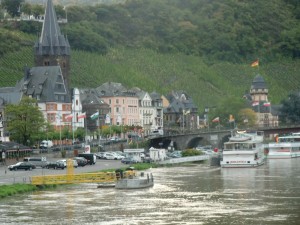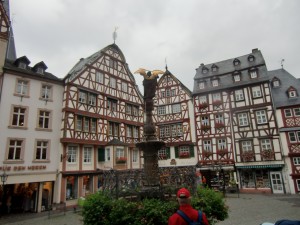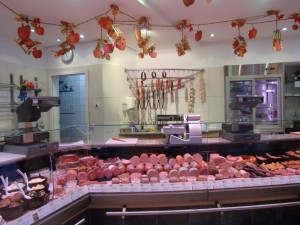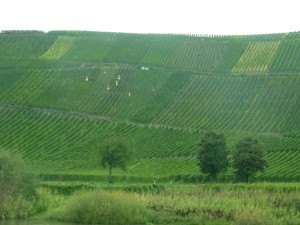CRUISING THE RHINE AND MOSEL RIVERS – WINE TASTING AT BERNCASTLE
CRUISING THE RHINE AND MOSEL RIVERS
This is the sixth in a series of articles about cruising the Rhine and Mosel Rivers
WINE TASTING AT BERNCASTLE
By Charles N. Stevens
Photos by Dolores Seidman
When we awake in the morning we are already docked at Berncastle, having arrived during the night. Gray clouds race across the sky, but the air seems warmer today, a nice relief. The steep slopes leading down to the river are, as usual, covered with vineyards. I think they produce enough wine along the Rhine and the Mosel to float the Queen Mary. The Romans were the first to tend vineyards here, and after two thousand years the vineyards are still here, having changed ownership down through the centuries.
On a walking tour, we stroll along the wharves and kiosks selling boat rides to the main street of town. Berncastle is a very small town tucked in between the river and the vineyard-covered hills. Still standing near the center of town is a 13th century tower, small openings like slits cut into its dull gray slate. Defenders hundreds of years ago used the slits to rain down arrows on the enemy.
By the time we reach the town square, we are surrounded by quaint gabled and half-timbered buildings and houses. They are a product of another age, one house dating from 1416, but are still being used for shops and living quarters. Most of the structures date from the 17th century. A person who lived here two hundred years ago or more would feel right at home should he return to life. Looking up to the tops of buildings, we’re treated to an array of golden weather vanes, some shaped like ships and others like roosters. A bakery shop displays varieties of breads and rows of baked goodies. I feel as though I’d like to walk in and order one of each. Nearby is a meat market complete with wurst and hanging sausages, especially blood sausage, dark and spiced with chilies. Bottles of Mosel wine gleam in the window of a wine merchant and expensive Birkenstock shoes appear in another.
We decide to slip into the church near the aforementioned tower. It is quiet, cold and silent inside the church. It’s nearly vacant too except for one other couple. We spend some quiet moments at the altar and looking up at the high, dove-white ceiling.
After an uphill trek, we arrive at the carved wooden door of the Doctorkeller Winery. Through this door we walk into a cave carved into the hillside, the temperature inside a chilly 50 degrees. Following an explanation about the wines of the area we begin to taste small samples, one at a time, out of small wine glasses. A very delicate Pinot Noir rolls around on our tongues, then a dry Riesling. We tried a late harvest wine, the sugars in the grapes concentrated so it produces a heavy, sweet wine. Stainless steel fermenting barrels, in another part of the cave, appear ghostly in the dim light. Our breaths steam as we sit in the damp cold sipping wine out of dainty glasses. The presenter tells us that the same family has owned these vineyards for 340 years and that General Eisenhower was presented a bottle of their wine during a state visit in 1950.
We have to adjust our eyes after emerging from the wine cave, but as we look up toward the slopes we spot an old castle, now so ruined that it looks like a jumbled pile of stones.
By midafternoon we are again cruising down the Mosel, leaving the lovely town of Berncastle behind. The sky has clouded over now and more and more rain dims the hillsides. We learn that the ubiquitous vineyards are largely picked by migrants from Eastern Europe. We relax in the coziness of our boat, watching the rain-dampened countryside pass by. Small villages appear on the hillsides, and sometimes the slopes open up into flatter land, again covered with vineyards right up to the river.
The boat captain hosts a party before dinner for repeat customers, complete with champagne and a variety of canapés.
Cruising along the river while dining is one of the greatest of pleasures. We begin our dinner meal with shrimp cocktail and corn chowder. I have spiced tenderloin for my entree, Dolores choosing salmon. All was followed by apple crumble topped with ice cream. Is it any wonder that people will endure long flights of thousands of miles and put up with the unpleasantness of airports to enjoy days like this?
Night gradually descends, blotting out everything except the occasional lights of unknown villages.

Berncastle is a small town tucked between the river and sloping vineyards.

Standing in Berncastle's main square, surrounded by centuries-old half-timbered buildings, we exist somewhere back in history.

This is a typical meat market in Berncastle, complete with wurst and hanging sausages.

The Mosel River is lined nearly its full length with steep vineyards.
MONTEREY PARK AUTHOR PUBLISHES 3RD BOOK ABOUT HIS EXPERIENCES IN WORLD WAR II- BACK FROM COMBAT
Charles “Norm” Stevens, a 40 year resident of Monterey Park and World War II Veteran has recently published the 3rd in his series about his experiences in WW II, Back from Combat: A WWII Bombardier Faces His Military Future. This book details the time from when he returned from combat in England where he flew 34 missions over Germany and France until the end of the war. Faced with large numbers of returning combat vets, and not knowing how long the war would continue, the military had to plan for their future. His options were whether to return to combat, become an instructor in the U.S., or receive new training that he would use in the Pacific. The book concludes with the end of the war with an Afterward that includes an update on the B-l7’s still flying in the U.S., as well as present day accounts pertaining to the war.
Stevens is the author of two previous books about his experiences:
An Innocent at Polebrook: A Memoir of an 8th Air Force Bombardier (Story of his 34 bombing missions from his base at Polebrook, England over Germany and France)
The Innocent Cadet: Becoming A World War II Bombardier (A prequel to the first, telling of his training in the U.S. before going overseas into combat.)
He is known to the readers of The Citizen’s Voice as the author of Travel Log Articles including “From Paris to Normandy on the Seine”, “Exploring New York” and “In Search of Snow.” He is retired, having taught for 32 years, primarily in the Montebello Unified School District.
Those interested in purchasing an autographed copy of any of his books, may contact the author at 323-721-8230 or Normstevens24@gmail.com.



